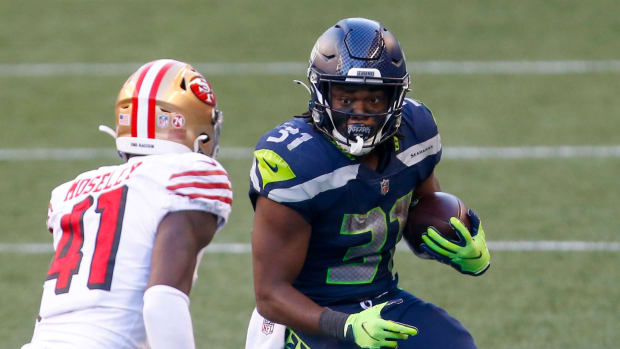Revisiting Seahawks Decision to Trade Frank Clark
On Sunday, Frank Clark will finally participate in his first conference championship game. But the veteran defensive end won’t be doing so as a member of his original team.
The 26-year old Clark has played a key role in a potential Super Bowl run for the Chiefs, registering a trio of sacks in last week’s remarkable 51-31 comeback win over the Texans in the divisional round. Prior to the playoffs, he’d registered a sack in three of the final four regular season games and has been playing his best football since the calendar turned to December.
This recent production illustrates why Kansas City was willing to ship a first-round pick as well as a 2020 second-round pick to Seattle to acquire Clark last April. After franchise tagging and trading Dee Ford to San Francisco, the team desperately needed a pass rusher who fit new defensive coordinator Steve Spagnuolo’s 4-3 scheme.
Signed to a five-year, $105.5 million extension, Clark struggled with just a single sack and three quarterback hits in Kansas City’s first six games, leaving some fans to feel a bit of buyer’s remorse.
But from Week 7 on, despite missing two games due to injury, Clark returned to his 2018 form when he led the Seahawks with a career-high 13.0 sacks. Over the next eight games, he posted 7.0 sacks, 11 quarterback hits, three pass deflections, and two forced fumbles as the Chiefs went 7-1 during that stretch to earn the No. 2 seed in the AFC.
As Clark prepares to face the upstart Titans in the AFC Championship Game at Arrowhead Stadium, his former team has already started a long, dark offseason, as the Seahawks were bounced from the playoffs last Sunday in a 28-23 loss to the Packers.
Ironically, the inability to rush the passer may be the biggest reason they’re sitting at home instead of gearing up for a rematch in Santa Clara. While Kansas City currently reaps the rewards of landing Clark, Seattle missed his presence off the edge dearly, finishing with just 28.0 sacks as a team, tied for the second-fewest in the NFL.
How did we reach this point? And how will this trade continue to impact both teams beyond 2019?
General manager John Schneider franchised Clark back in March 2018 with hopes a long-term deal could be reached, but he also knew his team needed more draft capital to continue reloading the roster. Seattle was slated to have only four picks, and once it became clear Clark wouldn’t play on the franchise tag and the two sides couldn’t agree on an extension, he wasted little time moving him for assets.
With the Chiefs first-round pick in hand, Schneider promptly traded back with the Seahawks’ native first-round pick at No. 21, acquiring the Packers first-round pick and two fourth-round selections. From there, he masterfully navigated the draft board with seven additional trades, winding up with 11 new players by the time the seventh round concluded.
One of the fourth-round picks acquired from Green Bay, along with a third-round pick acquired from the Panthers, was included in a deal to trade back into the second round and draft receiver DK Metcalf, who finished a sensational rookie season with 58 receptions, 900 receiving yards, and seven touchdowns.
Functioning like a mad scientist while working the phones with other teams, Schneider also drafted Marquise Blair, Ugo Amadi, Travis Ben Burr-Kiven, and Travis Homer through a series of trades stemming from Seattle’s original No. 21 pick.
Keeping this trade madness in mind, it’s way, way too early to determine who made out best in the Clark trade. After one season, the Chiefs look to have the upper hand, but the team may have been playing this weekend even if it didn’t make the trade thanks to an explosive offense orchestrated by quarterback Patrick Mahomes.
From the Seahawks perspective, the pass rush was hindered without Clark. Complicating matters, first-round pick L.J. Collier, who was selected with the Chiefs' first-round selection, struggled mightily as a rookie and rarely played.
But along with maintaining confidence Collier will still become a valuable contributor, the organization will continue to develop the five players who remain on their roster as a result of the additional flexibility afforded by having two first-round picks a year ago, with Metcalf being the headliner as a potential All-Pro caliber talent catching passes from Russell Wilson.
And if Schneider manages to re-sign Jadeveon Clowney, who was acquired from the Texans for a third-round pick and two reserve linebackers in August, the sting of losing Clark won’t hurt near as bad in the long run. The Seahawks also have enough cap flexibility to sign another quality pass rusher in free agency and still have the Chiefs’ 2020 second-round pick at their disposal for this year’s upcoming draft.
Knowing how Schneider operates, that could mean more than one new player will be joining Seattle’s roster in April to finalize the deal. While Kansas City looks to have won the trade for now, it’ll take several years to truly know who benefited the most and there's a good chance this eventually could be viewed as a rare win/win deal for both franchises.




